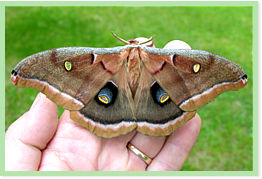
Mothin' at the Cottage
| By Doug Collicutt | (Click links for more images.) |

A gorgeous Polyphemus moth!
Ahhh . . . sunset at the cottage. Something I enjoy at any time of the year, but from late May through June, I feel a sense of excitement as the sun sinks. For as the darkness looms, the giant silk moths begin to stir. Tonight could be the night. It was sunny and warm today. The first real warm spell of the year began this week. Just before sunset, low clouds slid in to cover the sky. The new moon will set soon after the sun. When the night has settled in, it will be black, black dark. Perfect. Just the right ingredients for a major emergence. I can just feel them out there; their thick, furry bodies starting to vibrate, wings aquiver, as they shiver to generate heat for flight. Time for a coffee, an adjustment to the pillows in the big chair on the porch, and enjoyment of the gathering dark.
Full darkness . . .time for the light! A flick of the switch, a little humming and pulsing, then cool blue light from a long fluorescent tube bathes the outside of the porch. (Why are moths attracted to the light? You know, I couldn't find the "definitive" answer. The best guess seems to be that the light is not attractive, but rather is confusing to the moths, disorienting them when they venture too close. I'll keep checking and we'll post a better explanation when we find out for sure.) Now, back to my coffee; pull the book mark from the paperback and wait. No hurry now, they will come. Or maybe they won't. But if not, there's always another night. Such are the evenings in the life of a moth fancier during silk moth season.
The morning after a moth-trapping night can be exciting!
When you think of lepidopterists, those who fancy butterflies and moths, what image usually comes to mind? A pith-helmeted, khaki-shorts-wearing goof running through meadows chasing butterflies? Well, you're forgetting, of course, about the largest branch of the lepidoptera, the moths! There are 10 times more moth species than butterflies! And you won't see them by chasing around with a net. As moths are mainly active at night, the only thing you're likely to get by chasing around after dark is . . . poked in the eye with a pine bow! With moths, you have to get them to come to you!
An unusual catch, a Columbia Silk Moth.
|
Butterfly hunting is an active sport. You need to be fleet of foot, nimble and have quick hands to stalk, chase, swoop and scoop your quarry, usually on the fly. Moth fanciers, on the other hand, can be more sedentary, we are trappers not hunters. And I do my moth trapping from an easy chair, on the porch at my cottage, coffee in hand and book open on my lap. Actually I do some of my best moth trapping sound asleep. I just leave the light on all night and then inspect the cottage walls in the morning. But sometimes its nice to sit up late, enjoying the calm and the night sounds. And my favourite night sound is the light "whap", then buzzing "whir" of a large moth hitting, then crawling up the porch screen with fluttering wings. More than one cup of coffee has spilled in my lap, on hearing that sound and rushing to see what the light has drawn in.
Tonight, however, the night sounds are simply calming, no "whap and whir", just the occasional higher pitched "tung" of June beetles hitting the screen and bouncing off. It's way past my bed time now. I guess it wasn't "the" night after all. Oh well, another time. Still, we'll see what the morning brings.
Carry on for some biology of Giant Silk Moths!![]()
| You can help NatureNorth produce more great articles with a secure donation through PayPal. Our Google Adsense ads pay our server costs, but that's about it. To learn more follow this link: Support NatureNorth. Thank-you! | |
Return to: Spring Issue | NatureNorth Front page
